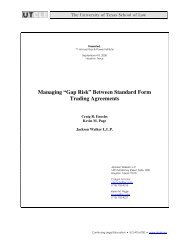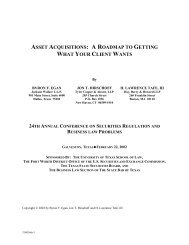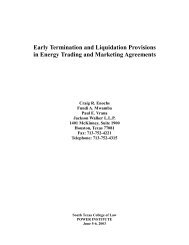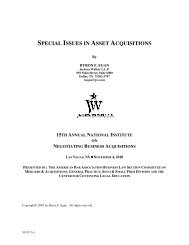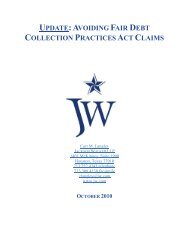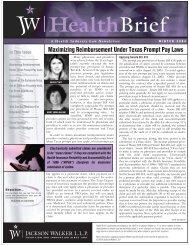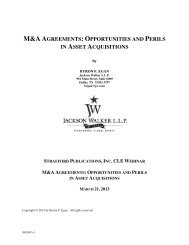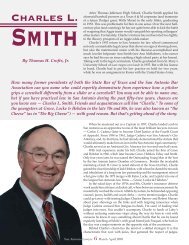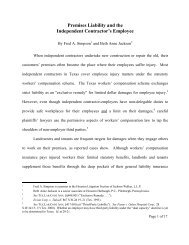A. Direct InfringementTo prevail under a theory <strong>of</strong> direct copyright infringement, a plaintiff must show that itowns the copyright in the work and that the defendant violated one or more <strong>of</strong> theplaintiff’s exclusive rights under the Copyright Act, 1 namely:1. reproduction <strong>of</strong> the work; 22. preparation <strong>of</strong> derivative works based on the work; 33. distribution <strong>of</strong> copies <strong>of</strong> the work; 44. public performance <strong>of</strong> literary, musical, dramatic, and choreographic works,pantomimes and motion pictures and other audio visual works; 55. public display <strong>of</strong> literary, musical, dramatic, and choreographic works,pantomimes and motion pictures and other audio visual works; 66. public performance <strong>of</strong> sound recordings by means <strong>of</strong> a digitial audiotransmission. 7B. Contributory InfringementMedia companies have long battled over the extent <strong>of</strong> contributory infringementliability, going back to the battle over the use <strong>of</strong> VCRs. In Sony Corp. v. Universal CityStudios, Inc., commonly known as the Betamax case, the Supreme Court held that thesale <strong>of</strong> a product with substantial non-infringing uses does not establish contributoryinfringement even where that product can also be used for infringing uses. 8However, in MGM Studios Inc. v. Grokster, Ltd., the Supreme Court refined Betamax,holding that contributory infringement may be established where a party distributes aproduct capable <strong>of</strong> both infringing and non-infringing uses with the clearly shownobjective <strong>of</strong> promoting copyright infringement. 9Thus, the elements <strong>of</strong> contributory infringement are:1. the party has knowledge <strong>of</strong> the infringing activity, and1 17 U.S.C. § 501(a).2 17 U.S.C. § 106(1).3 17 U.S.C. § 106(2).4 17 U.S.C. § 106(3).5 17 U.S.C. § 106(4).6 17 U.S.C. § 106(5).7 17 U.S.C. § 106(6).8 464 U.S. 417, 442 (1984).9 545 U.S. 913, 941 (2005).2
2. the party induces or materially contributes to the infringing conduct <strong>of</strong> adirect infringer. 10C. Vicarious InfringementVicarious infringement is one <strong>of</strong> the most hotly debated UGC legal issues. A partymay be held vicariously liable for another’s direct infringement if that party:1. has the right and ability to supervise the direct infringer, and2. has a direct financial interest in the infringing activity. 11D. Recently-Filed Copyright Cases1. Viacom v. <strong>YouTube</strong>On March 13, 2007, after licensing negotiations broke down, Viacom filed a$1 billion copyright infringement suit against <strong>YouTube</strong> and Google. 12Viacom alleges that, although “<strong>YouTube</strong>’s website purports to be a forumfor users to share their own original ‘user generated’ video content . . . ,” thesite promotes “rampant infringement” <strong>of</strong> others’ copyrights. Further,Viacom’s Complaint alleges, the widespread availability <strong>of</strong> such infringingcontent “is the cornerstone <strong>of</strong> [<strong>YouTube</strong>’s] business plan.” Viacomadvances claims for direct, contributory, and vicarious copyrightinfringement, as well as “inducement <strong>of</strong> copyright infringement.” Currently,the case is in the discovery phase. It is noteworthy that after the lawsuitcommenced <strong>YouTube</strong> implemented “audio fingerprinting” technology thatallows it to identify audio portions <strong>of</strong> videos that may infringe another’scopyright. <strong>YouTube</strong> is reportedly close to implementing similar technologyfor video content.2. UMG Recordings v. <strong>MySpace</strong>Several months before Viacom initiated its lawsuit, Universal Music GroupRecordings (“UMG”) sued <strong>MySpace</strong> for infringement, advancing similarclaims and requesting damages close to $1 billion. 13 UMG alleges that<strong>MySpace</strong> was guilty <strong>of</strong> copyright infringement by being a “willing partner” inthe unauthorized uploading <strong>of</strong> video and music content owned by UMG. Asa result <strong>of</strong> this conduct, UMG contends, <strong>MySpace</strong> is liable for direct,contributory, vicarious, and inducement copyright infringement as well as10 Id. at 930. Some have commented that, in Grokster, the Supreme Court set forth a new theory <strong>of</strong> secondaryinfringement, “inducement <strong>of</strong> copyright infringement,,” the elements <strong>of</strong> which are (1) an intent to induce infringement,even though no such inducement actually occurred, and (2) direct infringement. See id. at 936-37; 3 Melville B. Nimmer& David Nimmer, NIMMER ON COPYRIGHT § 12.04[A][4][b] (2006).11 Id. at 930.12 Viacom Intl, Inc. v. <strong>YouTube</strong>, Inc., et al., No. 06-02103 (S.D.N.Y.).13 UMG Recordings Inc. v. <strong>MySpace</strong> Inc., No. 06-07361 (C.D. Cal. complaint filed Nov. 17, 2006).3




